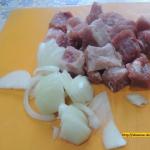Lysosomes are membrane organelles with a diameter of 0.2 to 2.0 µm. They are part of the eukaryotic cell, where hundreds of lysosomes are located. Their main task is intracellular digestion (breakdown of biopolymers); for this, the organelles have a special set of hydrolytic enzymes (about 60 types are known today). Enzyme substances are surrounded by a closed membrane, which prevents their penetration into the cell and its destruction.
The first to identify lysosomes and begin to study them was the Belgian scientist in the field of biochemistry, Christian de Duve, back in 1955.
Features of the structure of lysosomes
Lysosomes look like membrane sacs with acidic contents. The configuration is oval or round. All cells of the body contain lysosomes, with the exception of red blood cells.
A special difference between lysosomes and other organelles is the presence of acid hydrolases in the internal environment. They ensure the breakdown of protein substances, fats, carbohydrates, and nucleic acids.
Lysosomal enzymes include phosphatases (marker enzyme), sulfatase, phospholipase and many others. The optimal environment for normal functioning of organelles is acidic (pH = 4.5 - 5). If enzymes are insufficient or their activity is ineffective, or the internal environment is alkalized, lysosomal storage diseases (glycogenosis, mucopolysaccharidosis, Gaucher disease, Tay-Sachs disease) may occur. As a result, undigested substances accumulate in the cell: glycoproteins, lipids, etc.
The single-membrane membrane of lysosomes is equipped with transport proteins that ensure the transfer of digestion products from the organelle to the internal environment of the cell.

Are there lysosomes in a plant cell?
No. Plant cells contain vacuoles - formations filled with juice and enclosed in a membrane. They are formed from provacuoles that move away from the EPS and. Cell vacuoles perform a number of important functions: accumulation of nutrients, maintenance of turgor, digestion of organic substances (which indicates similarities between plant vacuoles and lysosomes).
Where are lysosomes formed?
The formation of lysosomes occurs from vesicles that bud from the Golgi apparatus. The formation of organelles also requires the participation of the granular membrane of the endoplasmic reticulum. All lysosomal enzymes are synthesized by ER ribosomes and then sent to the Golgi apparatus.
Types of lysosomes
There are two types of lysosomes. Primary lysosomes are formed near the Golgi apparatus and contain unactivated enzymes.
Secondary lysosomes, or phagosomes have activated enzymes that directly interact with the broken down biopolymers. As a rule, lysosomal enzymes are activated when the pH changes to the acidic side.
Lysosomes are also divided into:
- heterolysosomes- digestive substances captured by the cell by phagocytosis (solid particles) or pinocytosis (liquid absorption);
- autolysosomes- designed to destroy their own intracellular structures.
Functions of lysosomes in the cell
- Intracellular digestion;
- autophagocytosis;
- autolysis
Intracellular digestion Nutrient compounds or foreign agents (bacteria, viruses, etc.) that enter the cell during endocytosis are carried out under the action of lysosomal enzymes.
After digestion of the captured material, the breakdown products enter the cytoplasm, undigested particles remain inside the organelle, which is now called - residual body. Under normal conditions, the bodies leave the cell. In nerve cells that have a long life cycle, during the period of their existence many residual bodies accumulate, which contain the pigment of aging (they are also not excreted during the development of pathology).
Autophagocytosis- splitting of cellular structures that are no longer needed, for example, during the formation of new organelles; the cell gets rid of old ones by autophagocytosis.
Autolysis- self-destruction of the cell, which leads to its destruction. This process is not always pathological in nature, but occurs under normal conditions of development of the individual or during the differentiation of individual cells.
For example: cell death is a natural process for a normally functioning organism, therefore there is a programmed cell death - apoptosis. The role of lysosomes in apoptosis is quite large: hydrolytic enzymes digest dead cells and cleanse the body of those that have already fulfilled their function.
When a tadpole transforms into a mature individual, lysosomes located in the cells of the tail part break it down, as a result the tail disappears, and the digestion products are absorbed by the rest of the body cells.
Summary table of the structure and functions of lysosomes
| Structure and functions of lysosomes | |
|---|---|
| Stages | Functions |
| Early endosome | Formed by endocytosis of extracellular material. From the endosome, the receptors that have transferred their cargo (due to low pH) move back to the outer shell. |
| Late endosome | From the early endosome, sacs with particles absorbed during pinocytosis and vesicles from the lamellar complex with acidic enzymes pass into the cavity of the late endosome. |
| Lysosome | The vesicles of the late endosome pass to the lysosome and contain hydrolasing enzymes and substances for digestion. |
| Phagosome | Designed to break down large particles captured by phagocytosis. The phagosomes then combine with a lysosome for further digestion. |
| Autophagosome | The cytoplasmic region is surrounded by a double membrane and is formed during macroautophagy. Then it connects to the lysosome. |
| Multivesicular bodies | Single-membrane formations containing several small membrane sacs. They are formed during microautophagocytosis and digest material received from the outside. |
| Telolysosomes | Bubbles accumulating undigested substances (most often lipofuscin). In healthy cells, they connect to the outer membrane and leave the cell with the help of exocytosis. |
Lysosomes
- cellular organelles formed by a single membrane bilayer. Ligand-receptor complexes are destroyed in lysosomes
cholesterol metabolism
hydrolases destroy proteins, lipids, carbohydrates, nucleic acids
Inside the lysosomes, a constant pH = 5 is maintained, provided by an ATP-dependent pump, which, through the Na antiport
+
and H
+
pumps H
+
inside the lysosome. pH is also maintained by Cl-ion channels
Lysosome enzymes: ribonuclease, deoxyribonuclease, phosphatase, glycosidases, arylsulfatases (organic sulfuric acid esters), collagenase, cathepsins
Structure of lysosomal enzyme D cathepsin with attached sugar including mannose: PDB = 1LYA.
lgpA lgpB group of integral proteins 100-120 kDa, highly glycosylated. Glycosylation of self-membrane proteins prevents self-digestion.
Lysosome proteins are synthesized in the ER, passing through the trans-AG network, forming endosomes that fuse
d=0.2-2µm. degradation of cellular components, ~40 hydrolases (nucleases, proteinases, glycosidases, lipases, phosphatases, sulfatases, phospholipases) with an optimum pH~4.5-5 (in the cytoplasm ~7-7.3) - proton pumps - protection against cell degradation
proteins formed in the SER are glycosylated into AG, terminal mannose residues (Man) are phosphorylated at C-6, forming a terminal residue -
mannose 6-phosphate
(Man-6-P). AG receptors recognize Man-6-P, local accumulation of proteins in AG occurs -
clathrin
– cuts out and transports suitable membrane fragments as part of transport vesicles to endolysosomes. In endolysosomes, pH is lowered by proton pumps (H
+
-ATP-ase). Proteins dissociate from the receptors and the phosphate group is removed from Man-6-P. Man-6-P receptors are used a second time after recycling - they are transferred to AG.
trans-Golgi contains
mannose 6-phosphate receptor binding phosphorylated mannose of lysosomal enzymes,
directing enzymes to the transport vesicle.
Primary lysosomes.
Autophagy
– organelle capture =
secondary lysosomes
– process of hydrolytic splitting |
residual bodies.
Heterocytosis
– fusion of the lysosome with the endosomes of endo- and phagocytosis.
The membrane elements of lysosomes are protected from the action of acid hydrolases by oligosaccharide regions that are not recognized by enzymes or prevent hydrolases from interacting with them.
D-amino acid oxidase
– oxidizes D-amino acids to keto acids.
Destruction of proteins in lysosomes.
Cytoplasmic proteins can be degraded in proteasomes (see review
Proteasomes
) or in lysosomes. Degraded proteins have a specific site recognized by chaperones, which bind to the protein and transport it to receptors on the lysosome membrane. The protein is unraveled by chaperones and enters a channel leading into the lysosome, at the other end of which a protease cuts the protein into small fragments. The activity of this pathway is markedly reduced in fibroblasts and liver cells of old rats. This reduction promotes the accumulation of unnecessary proteins, disrupting various cellular processes.
Autophagy
During prolonged starvation, the cell takes energy and the necessary components for its survival by destroying some organelles. Lysosomes are involved in the destruction of organelles.
Organelles formed from lysosomes
In some differentiated cells, lysosomes can perform specific functions, forming additional organelles. All
additional functions are associated with the secretion of substances.
| organelles | cells | functions |
| melanosomes | melanocytes, retinal pigment epithelium |
formation, storage and transport of melanin |
| platelet granules | platelets, megakaryocytes | release of ATP, ADP, serotonin and calcium necessary for blood clotting |
| lamellar bodies | lung epithelium type II | storage and secretion of surfactant necessary for work lungs |
| lysis granules | cytotoxic T lymphocytes, NK cells |
destruction of cells infected with a virus or tumor |
| MCG class II | antigen presented cells (dendritic cells, B lymphocytes, macrophages, etc.) |
Change and presentation of antigens for CD4+ T lymphocytes for immune regulation |
| basophil granules | basophils, mast cells | trigger the release of histamines and other inflammatory incentives |
| azurophilic granules | neutrophils, eosinophils | release microbicidal and inflammatory agents |
| osteoclast granules | osteoclasts | bone destruction |
| Weibel-Pallade bodies | endothelial cells | maturation and regulated release of von Willebrand factor into the blood |
| platelet a-granules | Platelets, megakaryocytes | release of fibrinogen and von Willebrandt factor for adhesion platelets and blood clotting |
Diseases associated with lysosomes
Tay-Sachs disease
chediak-Higashi syndrome
Hermansky-Pudlak syndrome
Griscelli syndrome
Abbreviations.
ER - endoplasmic reticulum
AG - Golgi apparatus
Lysosome enzymes, like all proteins in general, are synthesized in ribosomes located in the folded membranes of the endoplasmic reticulum (see figure below).
Lysosomal enzymes (black dots), like all enzymes in general, are synthesized in the ribosomes of the endoplasmic network; then, in the immediate vicinity of the Golgi apparatus, they are packaged into small sacs - parent, immature granules. These granules develop into primary lysosomes and sometimes release their contents into the extracellular environment. But in most cases, enzymes are stored for intracellular digestion. Foreign particles enter the cell as a result of so-called endocytosis (left). Once they enter the cell, they find themselves inside phagosomes—vesicles bounded by a membrane. Primary lysosomes fuse with phagosomes, digestive enzymes enter the phagosomes, and as a result, secondary lysosomes are formed. The particles are digested, and the undigested material remains inside residual bodies, which remain in the cell for some time or fuse with the cell membrane, and then their contents are released into the extracellular environment.
Near the groups of vesicles that form the so-called Golgi apparatus, lysosomal enzymes are packaged into organelles surrounded by a single lipoprotein membrane. These parent granules develop into primary lysosomes, in which the enzymes, although in an inactive form, are ready for use at any time.
As soon as lysosomes were identified, it was almost immediately discovered that many cytoplasmic particles already familiar to biologists, which were quite diverse in appearance, also belonged to lysosomes. Perhaps the most typical lysosomes are the characteristic granules that are constantly found in the cytoplasm of leukocytes. But in all other cells of animal origin studied so far, with the exception of erythrocytes, there are organelles containing hydrolytic enzymes and, therefore, belonging to the category of lysosomes. Similar organelles are found in plants, including fungi and yeast.
Bacteria do not have lysosomes in the form in which they are found in higher organisms, but with the help of certain methods it is possible to isolate from them hydrolytic enzymes with properties similar to those of lysosomes. In other words, the presence of lytic (i.e., digesting) enzymes, usually enclosed in membranes, but capable of being released into the external environment under certain influences, appears to be one of the most common characteristics of living organisms.
"Molecules and Cells", ed. acad. G.M. Frank
Prevalence among living kingdoms
Lysosomes were first described in 1955 by Christian de Duve in animal cells, and were later discovered in plant cells. In plants, vacuoles are similar to lysosomes in the method of formation, and partly in function. Lysosomes are also present in most protists (both with phagotrophic and osmotrophic types of nutrition) and in fungi. Thus, the presence of lysosomes is characteristic of cells of all eukaryotes. Prokaryotes do not have lysosomes because they lack phagocytosis and do not have intracellular digestion.
Signs of lysosomes
One of the characteristics of lysosomes is the presence in them of a number of enzymes (acid hydrolases) capable of breaking down proteins, carbohydrates, lipids and nucleic acids. Lysosome enzymes include cathepsins (tissue proteases), acid ribonuclease, phospholipase, etc. In addition, lysosomes contain enzymes that are capable of removing sulfate (sulfatases) or phosphate (acid phosphatase) groups from organic molecules.
see also
Links
- Molecular Biology Of The Cell, 4th edition, 2002 - textbook on molecular biology in English


















